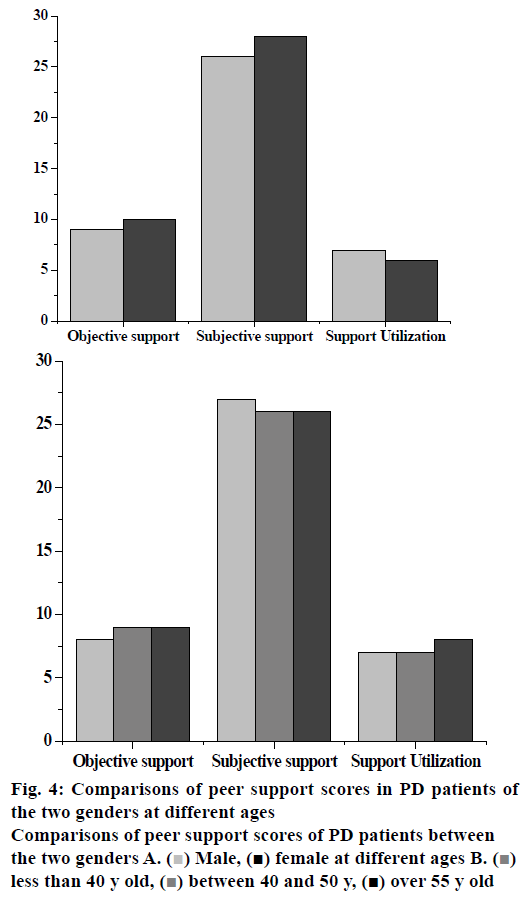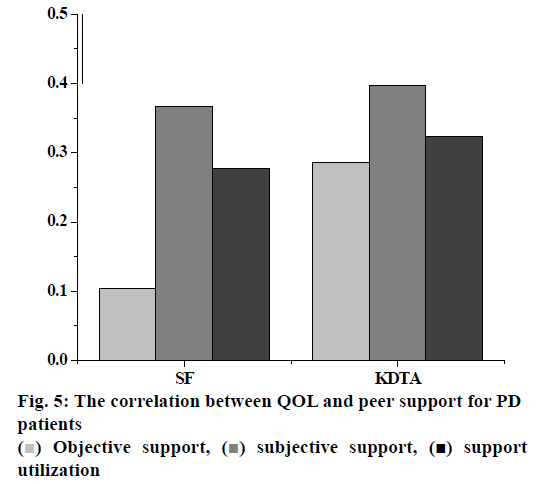- *Corresponding Author:
- Y. Cai
Department of Nephrology, People's Hospital of Wuxi, Wuxi 214000, China
E-mail: luq1662935168@163.com
| This article was originally published in a special issue, "Clinical and Experimental Studies on Drug and Intervention Repurposing in China |
| Indian J Pharm Sci 2019:81(4)spl issue1;109-115 |
This is an open access article distributed under the terms of the Creative Commons Attribution-NonCommercial-ShareAlike 3.0 License, which allows others to remix, tweak, and build upon the work non-commercially, as long as the author is credited and the new creations are licensed under the identical terms
Abstract
In order to understand the living conditions and quality of life of peritoneal dialysis patients as well as the status of peer support, a cross-sectional survey method was conducted. Besides, the correlation between quality of life of peritoneal dialysis patients and peer support was explored in this research. A total of 125 peritoneal dialysis patients were selected by random sampling method for questionnaire survey. The questionnaires used in this experiment included general information questionnaire, dialysis-related quality of life scale and peer support rating scale. The database was built using the SPSS19.0 software package. Statistical methods of descriptive statistical analysis, t-test comparison of two mean values, analysis of variance comparison of multiple mean values, multiple linear stepwise regression analysis and Spearman rank correlation were employed. The results showed that in the sub-dimension of quality of life of peritoneal dialysis patients, the scores of physical role function, emotional role function and sexual function were all 0. The scores of male patients in general health, social function, kidney disease and dialysis total score, symptoms, nephropathy, cognitive function, social quality and satisfaction were lower than those of female patients. In peer support, the scores of both subjective support and objective support of female patients were higher than those of male patients, while male patients had higher support utilization scores than female patients. In the correlation analysis of quality of life and peer support in peritoneal dialysis patients, the quality of life dimensions related to the total score of peer support included SF, somatic function, somatic role function, pain, general pain, mental health, emotional role function, social function, nephropathy impact, nephropathy burden and social quality. The factors influencing the quality of life of peritoneal dialysis patients were gender, age and family monthly income. The quality of life of peritoneal dialysis patients was positively correlated with peer support.
Keywords
Peritoneal dialysis, cross-sectional survey, quality of life, relevance analysis, peer support
Peritoneal dialysis (PD) is based on peritoneum as a dialysis membrane, which is a method of injecting dialysate into the abdominal cavity[1]. By means of capillaries and micro vessels on both sides of the membrane, as well as plasma concentration gradient and osmotic gradient in PD fluid, the residual metabolic wastes and excessive water in vivo can be removed by the principles of dispersion, convection and ultrafiltration[2]. PD is one of the important alternative therapies for patients with end-stage renal disease[3]. PD is an effective renal replacement therapy with the advantages of high early survival rate, good residual renal function protection and low cross-infection rate. In China, more than 80 % of dialysis patients choose PD therapy[4]. With the improvement of PD technology and equipment, the complications and mortality of dialysis patients are reduced and the survival time is prolonged. Health care workers are paying more and more attention to the quality of life (QOL) of dialysis patients[5].
QOL is a concept that has been widely used recently[6]. In 1993, WHO proposed that health-related QOL refers to the experience of individuals in different cultural and living conditions value systems, which is related to their goals, expectations, standards and concerns, including their physical health, psychological state, independence, social relations, personal lies and relationship with the surrounding environment[7]. The study of QOL began in the 1940s. Since the mid-1960s, the QOL of patients with end-stage renal disease has been studied[8]. Since the 1980s, the QOL of patients with chronic dialysis has attracted the attention of many scholars, but at this time, it is mainly chronic hemodialysis patients[9]. Since the early 1990s, reports on the QOL of PD patients have begun to increase.
Peer support refers to the spiritual and material help and support that individual receives from friends, colleagues and partners. It reflects the degree and quality of a person's social interaction as well as the ability to reduce stress. In the process of emphasizing the relationship between social relations and health, the available external resources of individuals have been studied by academia for a long time[10]. As an environmental mediator, peer support can improve patients' treatment compliance and QOL. Studies have shown that peer support can affect the QOL of patients with various chronic diseases[11]. At present, there are few studies on the correlation between QOL and social support and coping styles of PD patients at home and abroad[12].
In this study, the QOL and peer support of PD patients were investigated using a questionnaire. Based on the analysis of the factors affecting QOL, this study explored the relationship between the QOL of PD patients and peer support. Theoretical and scientific basis were also provided for nursing staff to improve the QOL of PD patients in the future.
Materials and Methods
A cross-sectional investigation was carried out. A total of 125 PD patients who met the inclusion criteria were randomly selected for the questionnaire survey. The inclusion criteria for the study subjects were those who exceed 18 y of age and have undergone PD for more than 3 mo. They have certain reading and communication skills and agreed to participate in this study. The exclusion criteria of the subjects were illiteracy, communication difficulties, mental disorders, blindness and deafness. According to the simple random sampling, the formula for estimating the sample size required for the population mean is as follows[13], n = (ua/2σ/δ)2, if a=0.05 and the control error does not exceed 2.5, the sample size required for this study should at least be n = (u0.05/2×13.7/2.5)2 = 115. Considering that part of the questionnaires might be lost and the returned questionnaires were not 100 % complete and valid, a part of the sample of the questionnaire was added on this basis. In this questionnaire survey, general information about patients, QOL scale and social support scale were needed.
QOL scale:
Kidney disease and QOL- short form (KDQOL-SFTM) scale was used. KDQOL-SFTM scale is a scale developed in recent years to assess kidney disease and dialysis-related QOL, which has been widely used in dialysis patients. In 36-item health survey brief form (SF-36) and the overall health assessment, there were 43 items in kidney disease and dialysis (KDTA), which were divided into N aspects, symptoms, effect of kidney disease (ECD), burden of kidney disease (BKD), working status (WS), cognitive function (CF), quality of social interaction (QSI), sexual function (SF), sleep (S), social support, dialysis staff encouragement (DSE) and patient satisfaction (PS). In the KDQOL-SFTM scale, the scores of each item were between 0 and 100, and the average scores of all items on the spot were divided into the scores of all items on the spot. The higher the score, the higher the QOL in this field. KDQOL-SFTM achieved the Kranbach coefficient of 0.874 in the previous investigation of this study[14].
Peer support scale:
The peer support scale has good reliability and validity. There are 10 items in the scale, including 3 objective support, 4 subjective support and 3 peer support. Each item scores 1-4 points, and the sum of each item constitutes the scores of objective support, subjective support and peer support utilization, respectively. The sum of these three scores constitutes the total score of peer support. In the previous survey, the Cronbach coefficient was 0.637.
Quality control:
Prior to the investigation, the investigators were trained uniformly and strictly to understand the questionnaire rules used in the survey. The questionnaire was anonymous. Before issuing the questionnaires, the patients were informed that filling out the questionnaires had no effect on the hospitalization, so the patients could fill out the questionnaires safely. Questionnaires were sent out with the consent of the patients. In the pre-survey prior to the formal investigation, the investigators used a unified questionnaire and survey criteria. The investigation environment was quiet and the patient's mood was stable. In this study, the data were collected by on-site recycling, and appropriate explanations were given to the patients who have doubts in order to ensure the accuracy and completeness of data collection as far as possible. Before performing data analysis, the encoding and input of data were checked for errors, omissions and logic[15].
Social support for PD patients:
In the survey, 86.4 % of the couples received full support, 40.8 % have no parents, 48.8 % have full support, 81.6 % have full support from their children, 68 % received full support from their brothers and sisters, 45.6 % have full support from their family members, and most of the subjects believe that couples and children have adequate care for themselves. The three main sources of income were spouse (39.2 %), other family members (26 %) and relatives (25 %). The three main sources of emotional support were spouse (30.4 %), friends (21 %) and relatives (21 %). Obviously, most respondents believe that family members are the main source of social support. These findings were also related to the strong family beliefs and the help of family members in difficult times. In the group activities, 31.2 % never participated, 52.8 % participated occasionally, 8.8 % participated regularly and 7.2 % actively participated, of which 16 % participated regularly and actively. It can be seen that the social participation of PD patients was poor. The activities and participation of 171 patients with endstage renal disease (more than 3 mo after treatment) were assessed using the social dysfunction screening scale (SDSS). 75.4 % of the respondents participated in social activities to a certain extent. The poor participation of PD patients in social activities may be attributed to their unwillingness to communicate with their neighbors as they think others will despise their dialysis treatment. This may also be related to cultural factors. In the study, patients with chronic diseases in the United States and Asia were found to have differences in social participation. Americans prefer to spend more time on work and entertainment, and have more contacts with business partners, while Asian patients prefer to connect with friends and family[16].
Statistical analysis:
The database was built with SPSS19.0 software package. Statistical analysis methods include descriptive statistical analysis, t-test, variance analysis, multiple linear stepwise regression analysis and Spearman rank correlation. P<0.05 was considered to be statistically significant, and all values showed a bilateral probability.
Results and Discussion
In this study, 125 PD patients were observed. At the beginning of the survey, each person filled out a questionnaire. After answering the questionnaire, the questionnaire was collected and the results were observed. Among the 125 PD patients in this study, the average age was 50 y, of which 70 were male, accounting for 56 % of all patients, and 55 were female, accounting for 44 % of the total number of patients surveyed. In the case of random experiments, this phenomenon also indirectly indicates that there were more male PD patients than female patients. In this experiment, 125 PD patients were taken as subjects. At the beginning of the survey, each person has to fill out a questionnaire. In this experiment, 38 patients were less than 40 y old and 47 patients exceeded 55 y old, while the average age of the experimental patients was 50 y old, which proves that among the PD patients, the proportion of the elderly population is the largest in China. Among the respondents in this article, the number of unemployed patients was the lowest, only 10, accounting for 8 % of the total number of respondents. The number of white-collar workers was 65, accounting for 52 % of the total respondents. Most of the patients received secondary education, 79 cases, accounting for 63.2 % of the total number of surveys. Among the respondents, 86 patients suffering from hypertension, diabetes and other diseases, accounting for 68.8 % of the total respondents. In this survey, most of the patients have dialysis time of less than one year, 65 cases, accounting for 52 % of the investigated population (Table 1). The QOL reflects the individual's role and subjective state in physical, psychological and social life. In this study, the average score of the overall health assessment of PD patients was 45.00 (38.00-58.00). It can be seen from the data that in the sub-dimension of life quality of PD patients, the scores of body role function, emotional role function and SF were all zero. The scores of PD patients were higher in mental health, symptoms, social quality and encouragement to dialyzers. The results showed that in general, the scores of male patients in general health, social function, KDTA total score, symptoms, nephropathy, CF, social quality and satisfaction were lower than those of female patients because female patients have better compliance than male patients (Table 2).
| Variable | Grouping | Number of cases | Percentage (%) |
|---|---|---|---|
| Gender | Male | 70 | 56 |
| Female | 55 | 44 | |
| Age | <40 y old | 38 | 30.40 |
| 40-55 y old | 40 | 32 | |
| > 55 y old | 47 | 37.60 | |
| Marriage | Single | 12 | 9.60 |
| Married | 113 | 90.40 | |
| Job | White Collar | 65 | 52 |
| Farmer | 30 | 24 | |
| Worker | 20 | 16 | |
| Unemployed | 10 | 8 | |
| Education | University | 35 | 28 |
| Middle school | 79 | 63.20 | |
| Primary school | 11 | 8.80 | |
| Disease | Nephropathy | 39 | 31.20 |
| Complicated with hypertension, diabetes, etc. | 86 | 68.80 | |
| Dialysis time | <1 year | 65 | 52 |
| 1-2 y | 17 | 13.6 | |
| >2 y | 43 | 34.40 |
Table 1: General information of the subjects
| Dimension | Subdimension | x±SD/M (p25–p75) |
|---|---|---|
| SF | 40.57 (30.24-50.63) | |
| Physical function (PF) | 54.32 (42.00-76.00) | |
| Role physical (RP) | 0.00 (0.00-23.00) | |
| Pain physical (BP) | 56.84 (44.00-68.30) | |
| General health (GH) | 35.00 (20.00-45.00) | |
| Mental health (MH) | 58.00 (45.00-70.00) | |
| Role emotion (RE) | 0.00 (0.00-64.38) | |
| Social function (SF) | 39.47 (32.12-52.00) | |
| Vitality (VT) | 49.00 (29.00-49.00) | |
| KDTA | 53.64±11.75 | |
| Symptoms | 65.32 (56.36-80.45) | |
| Effect of kidney disease (EKD) | 50.34±19.78 | |
| Burden of kidney disease (BKD) | 26.00 (11.80-44.65) | |
| Cognitive function (CF) | 55.00 (52.56-78.00) | |
| Quality of social interaction (QSI) | 67.39 (52.56-78.00) | |
| Sleep | 56.90 (43.00-68.00) | |
| Working status (WS) | 48.00 (0.00-48.00) | |
| Sexual function (SEF) | 0.00 (0.00-46.64) | |
| Social support (SoS) | 55.55 (40.00-55.56) | |
| Dialysis staff encouragement (DSE) | 60.30 (48.00-80.31) | |
| Patient satisfaction (PS) | 45.00 (45.00-57.42) |
Table 2: Scores of all dimensions of QOL in PD patients
The scores of physical function, emotional role function and social function were higher in the dimension of life quality of normal people, while those of PD patients were higher in the dimension of life quality of physical function, pain and social function. The physical and social functions of the two groups were the same. Comparing the QOL of PD patients with that of normal people, it was found that the dimension of life quality of normal people was significantly higher than that of PD patients, especially in the aspects of physical role function, emotional role function, social function and physical function. The difference between life quality dimension of the normal population and PD patients were statistically significant (p<0.05, fig. 1).
The scores of the female patients were higher than male patients in terms of symptoms, the effect of kidney disease, BKD, CF and QSI (fig. 2). The scores of KDTA and physical function of different genders were 0.523 and 0.163, respectively. The t-test of complete randomized design was used to compare the 2 means. The t-test values of symptoms, effect of kidney disease, BKD, CF and QSI were -2.547, -1.986, -0.964, -3.457 and -3.861, respectively. From the effects of kidney disease, the BKD, CF and QSI, the symptoms of female patients were significantly different from those of male patients, and the difference was statistically significant (p<0.05).
KDTA patients under the age of 40 scored higher than the other 2 groups, the difference was significant. The SF scores of patients aged 40-55 were higher than the other 2 groups. The variance analysis of multiple mean comparisons showed that the variance of KDTA scores in different age groups was the same, while the variance of SF scores was uneven. The results showed that the scores of life qualities for patients older than 55 y old were lower than those patients under 40 y old and between 40 and 55 y old. Thus, with the increase of age, the QOL dimensions of PD patients (social quality, KDTA, sleep quality, emotional role function, CF, SF) were decreasing. The overall QOL of PD patients decreased with age (fig. 3).
In the condition of peer support for PD patients, the utilization of peer support was 9.00, and the total score of peer support was 45.00. The median value of subjective support was significantly different from the objective support, which were 28.00 and 8.00, respectively.
The male patient's peer support scores were not all normally distributed. The scores of subjective support and objective support of female patients were higher than those of male patients, while male patients had higher support utilization scores than female patients. The Mann-Whitney U test with two independent samples showed no significant difference in the overall position of the scores for the other dimensions (fig. 4).
The peer support scores of PD patients with different ages were not all normally distributed. As shown in the fig. 4, the objective support score for patients under 40 y old was 8.00±3.57. The objective support scores of patients aged 40-55 y old and those over 55 y old were the same, which were higher than those of patients under 40 y old. Unlike objective support, patients under 40 y old had higher subjective support scores than those between 40 and 55 y of age and over 55 y of age. In terms of support utilization, the scores of the patients under 40 y old were the same as those aged between 40 and 55 y old, but they are all younger than those 55 y old. Statistical analysis showed that there was no significant difference in the overall distribution of peer support scores among different age groups of PD patients (fig. 4).
The correlation between QOL and peer support was analyzed. The objective support, subjective support, utilization of peer support and peer support were divided into independent variables, while the dimensions of KDTA and SF were strain variables. The results showed that the QOL of PD patients was positively correlated with peer support. Based on the table below, the correlation coefficients of SF with objective support, subjective support, utilization of peer support and total score of peer support were 0.104, 0.367, 0.278 and 0.319, respectively. The correlation coefficients of KDTA with objective support, subjective support, utilization of peer support and total score of peer support were 0.286, 0.397, 0.323 and 0.385, respectively. In addition, peer support is positively correlated with most dimensions of QOL. Among them, emotional role function, mental health, physical function, pain and general pain are correlated with objective support in all dimensions of QOL. On the other hand, SF, social function, KDTA, sleep quality, symptoms and discomfort, BKD, PS and DSE are all related to subjective support. The dimensions of QOL related to support utilization including SF, pain, general pain, role emotion, effect of kidney disease, BKD, QSI, WS, social support, physical role function, PS and DSE. The QOL dimensions related to the total score of peer support are SF, physical function, physical role function, pain, general pain, mental health, role emotion function, social function, effect of kidney disease, BKD, QSI, sleep quality, SF, social support and DSE (fig. 5).
In this investigation, it was found that the dimensions of QOL such as SF, social quality, KDTA, sleep quality, emotional role function, CF and SF of PD patients gradually decreased with age, which was consistent with previous studies. The overall QOL of PD patients decreased with age. The patients aged from 40 to 55 y old and those older than 55 y old scored significantly lower than patients under 40 y of age. The results of this study indicated that the three dimensions of QOL in PD patients were the lowest, including physical role function, emotional role function and SF. The two dimensions of QOL had the highest scores, namely the encouragement of dialysers and social quality. This also showed that PD patients often reduce their work or activity time due to health and emotional reasons, and can only accomplish part of their work. Moreover, it can be seen from the survey results that the dimension of QOL of normal people was significantly higher than that of PD patients, especially in the aspects of physical role function, emotional role function, social function and physical function. The scores of symptoms, nephrotic effects, nephrotic burden, CF and social quality of female patients were higher than those of male patients. Female patients had higher subjective support and objective support scores than male patients, while the scores of support utilization of male patients were higher than female patients. According to domestic and foreign researches, peer support is the second most important support.
In summary, the following conclusions could be drawn. Firstly, the scores of the male patients were generally lower than female patients in general health, social function, KDTA total score, symptoms, nephropathy, CF, social quality and satisfaction, because female patients have better compliance compared to male patients. Secondly the correlation analysis between QOL and peer support suggests a positive correlation between QOL and peer support. In other words, the more peer support a patient gets, the better their QOL will be. This demonstrates that family members and medical staff can improve the QOL of patients by improving peer support methods, such as care for patients, health education, psychological intervention and so on.
Acknowledgement:
This project was supported by the Youth Program of Wuxi Municipal Health and Family Planning Commission (Grant No. Q201810).
References
- Baillie J, Lankshear A. Patient and family perspectives on peritoneal dialysis at home: findings from an ethnographic study. J Clin Nurs 2015;24(1-2):222-34.
- Flythe JE, Hilliard T, Castillo G, Ikeler K, Orazi J, Abdel-Rahman E, et al. Symptom prioritization among adults receiving in-center hemodialysis: A mixed methods study. Clin J Am Soc Nephrol 2018;13(5):735-45.
- Bergjan M, Schaepe C. Educational strategies and challenges in peritoneal dialysis: A qualitative study of renal nurses’ experiences. J Clin Nurs 2016;25(11-12):1729-39.
- Prakash S, McGrail A, Lewis SA, Schold J, Lawless ME, Sehgal AR, et al. Behavioral stage of change and dialysis decision-making. Clin J Am Soc Nephrol 2015;10(2):197-204.
- Walker RC, Hanson CS, Palmer SC, Howard K, Morton RL, Marshall MR, et al. Patient and caregiver perspectives on home hemodialysis: a systematic review. Am J Kidney Dis 2015;65(3):451-63.
- Jamieson NJ, Hanson CS, Josephson MA, Gordon EJ, Craig JC, Halleck F, et al. Motivations, challenges, and attitudes to self-management in kidney transplant recipients: a systematic review of qualitative studies. Am J Kidney Dis 2016;67(3):461-78.
- Palmer SC, Hanson CS, Craig JC, Strippoli GF, Ruospo M, Campbell K, et al. Dietary and fluid restrictions in CKD: a thematic synthesis of patient views from qualitative studies. Am J Kidney Dis 2015;65(4):559-73.
- Moreira JM, Bouissou Morais Soares CM, Teixeira AL, Simões E, Silva AC, Kummer AM, et al. Anxiety, depression, resilience and quality of life in children and adolescents with pre-dialysis chronic kidney disease. Pediatr Nephrol 2015;30(12):2153-62.
- Obi Y, Streja E, Rhee CM, Ravel V, Amin AN, Cupisti A, et al. Incremental hemodialysis, residual kidney function, and mortality risk in incident dialysis patients: a cohort study. Am J Kidney Dis 2016;68(2):256-65.
- Prihodova L, Nagyova I, Rosenberger J, Roland R, Majernikova M, Groothoff JW, et al. Social participation after kidney transplantation as a predictor of graft loss and mortality over 10 years: A longitudinal study. Transplantation 2015;99(3):568-75.
- Peipert JD, Bentler PM, Klicko K, Hays RD. Psychometric properties of the kidney disease quality of life 36-item short-form survey (KDQOL-36) in the United States. Am J Kidney Dis 2018;71(4):461-8.
- Geense WW, van Gaal BGI, Knoll JL, Cornelissen EAM, van Achterberg T. The support needs of parents having a child with a chronic kidney disease: a focus group study. Child Care Health Dev 2017;43(6):831-8.
- Chowdhury R, Peel NM, Krosch M, Hubbard RE. Frailty and chronic kidney disease: a systematic review. Arch Gerontol Geriat 2017;68:135-42.
- Balogun SA, Balogun R, Philbrick J, Abdel-Rahman E. Quality of life, perceptions, and health satisfaction of older adults with end‐stage renal disease: A systematic review. J Am Geriatr Soc 2017;65(4):777-85.
- Medyńska A, Zwolińska D, Grenda R, Miklaszewska M, Szczepańska M, Urzykowska A, et al. Psychosocial aspects of children and families treated with hemodialysis. Hemodial Int 2017; 21(4):557-65.
- Chan CT, Wallace E, Golper TA, Rosner MH, Seshasai RK, Glickman JD, et al. Exploring Barriers and Potential Solutions in Home Dialysis: An NKF-KDOQI Conference Outcomes Report. Am J Kidney Dis 2019;73(3):363-71.
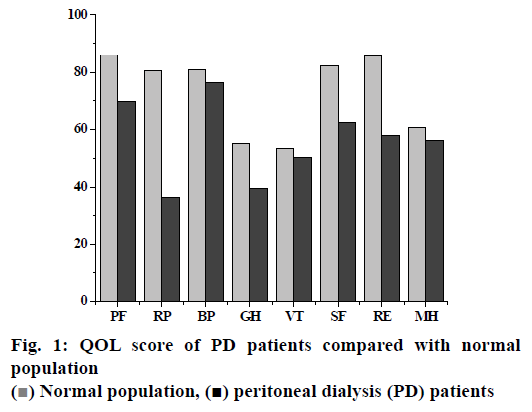
 ) Normal population, (
) Normal population, ( ) peritoneal dialysis (PD) patients
) peritoneal dialysis (PD) patients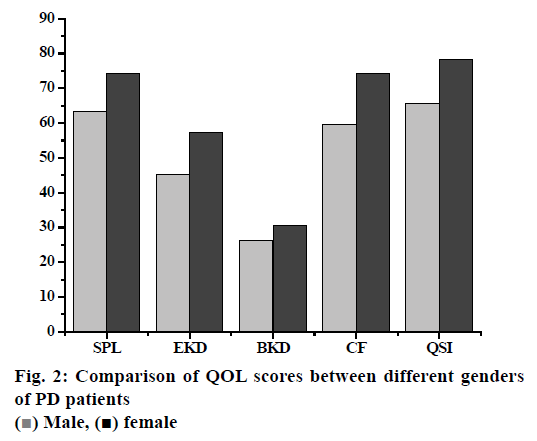
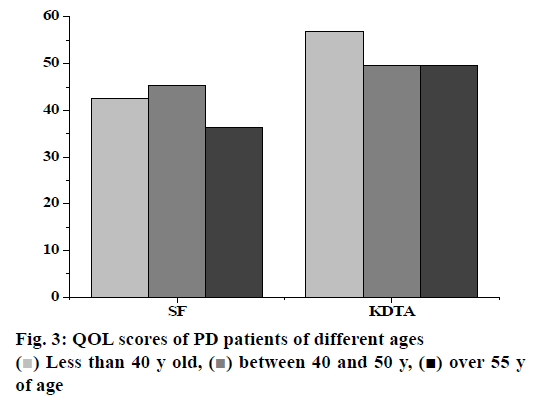
 ) Less than 40 y old, (
) Less than 40 y old, (